What to do if the leaves of the ficus turn yellow?

It so happens that suddenly the leaves of the ficus turn yellow and begin to fall off, in this case the novice grower does not always understand what needs to be done. To understand the problem, you will first need to determine why this is happening, since the reasons can be different.
The main reason
The main reason why yellow leaves appear is chlorosis. It can indicate various problems. As a result, there is too little chlorophyll, a pigment used by plants to absorb sunlight needed for photosynthesis. It is chlorophyll that gives the leaves their green color, an insufficient supply turns them into pale green, yellow or yellowish-white. A chlorotic flower may not survive unless the source of the deficiency is eliminated.
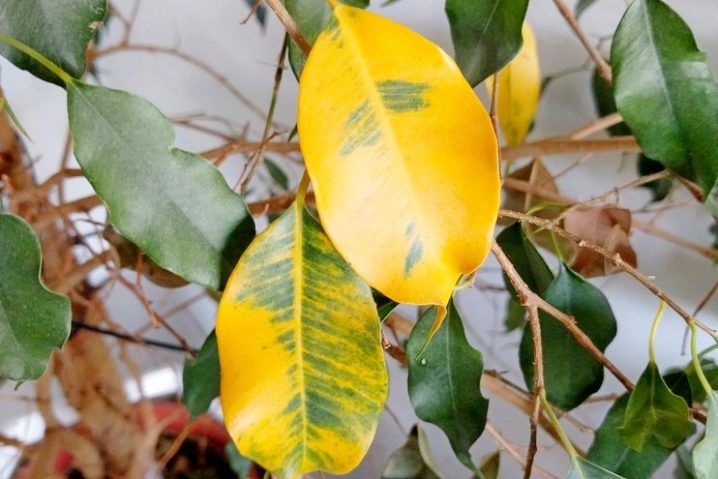
Factors of improper care
It is perfectly natural for old leaves to turn yellow and fall off over time. But sometimes young shoots do not develop further either. More often than not, the leaves begin to turn yellow along with seasonal changes in temperature or humidity. As for the room conditions, in this way the ficus demonstrates its dissatisfaction with the surrounding space, perhaps a draft has appeared or it has become cooler, the flower does not receive moisture.
Temperature
The development of ficus is negatively affected not only by a draft, which a person cannot always notice, but also by a change in the temperature in the room. The difference of 7 degrees is already noticeable for the flower, hence the yellowing of the foliage. However, the same reaction will be if you put the pot near a working air conditioner or heater. Ideally, the temperature range should be + 15– + 20 ° C. Do not place the plant near ventilation openings, central heating, as this will lead to a change in humidity levels. If it is quite low, then unwanted yellowness will appear, spots and leaves will begin to fall off.
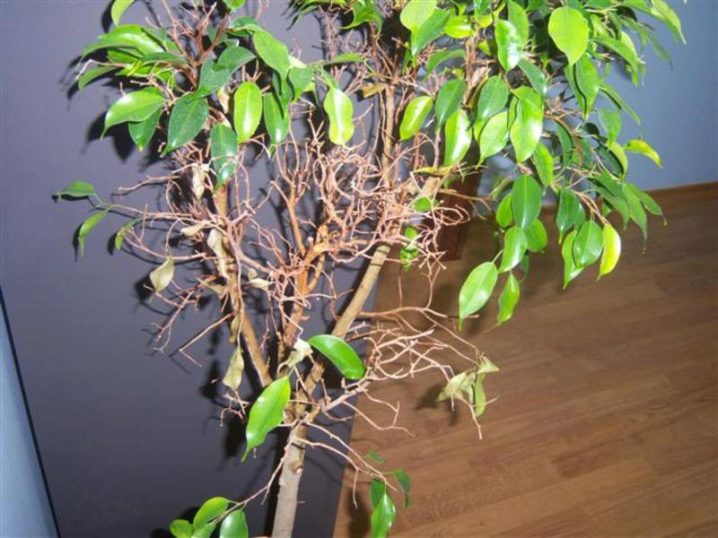
Light
Although this plant loves a lot of light, it does not need direct sunlight. The grower must make sure that filtered light is shining in the chosen spot. Active exposure to the sun leads to burns, but an insufficient amount leads to yellowing, the lower leaves begin to crumble, the plant loses strength.
Watering
Over-watering is one of the main causes of yellow foliage. Although the soil should be moist, it should not be waterlogged. Problems arise when the pot has no drainage holes or is closed. As a result, excess liquid remains inside, which leads to the development of root rot, and this can cause discoloration of the foliage, since enough nutrients are no longer absorbed by the root system. Good watering involves removing excess water later.
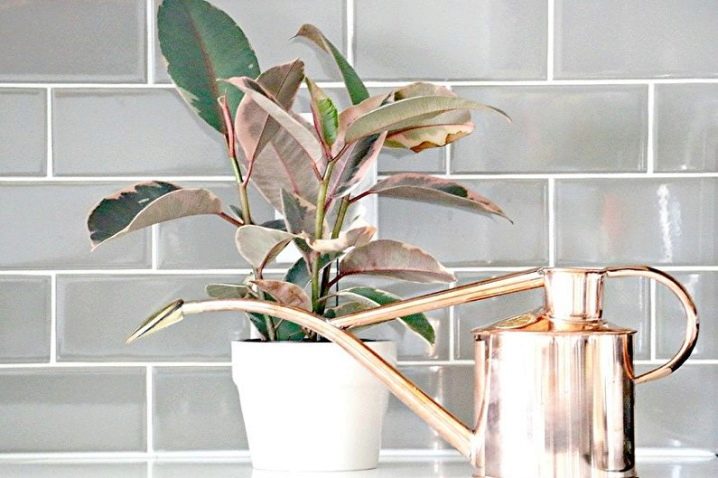
The plant should not be allowed to be constantly in the water. Excess water is even removed from the drain pan. The soil must dry out before watering the plant again.
Overgrown roots
Regardless of the species, ficus is a plant that grows quickly, so the root system can outgrow the pot. Roots become cramped in a confined space, which limits the supply of nutrients and water. This inhibits the growth of the flower, lack of nutrition can lead to yellowing of the leaves or death. In this case, you should consider transferring to a larger container. Fertilizer is not applied after the procedure, as it increases the load. First you need to wait until the flower acclimatizes, new shoots should appear.
Try to keep the environment as stable as possible, keep the bush away from double-glazed windows, doors, air conditioners and heaters, use a humidifier in winter when the air gets too dry, and don't move the tree too often.
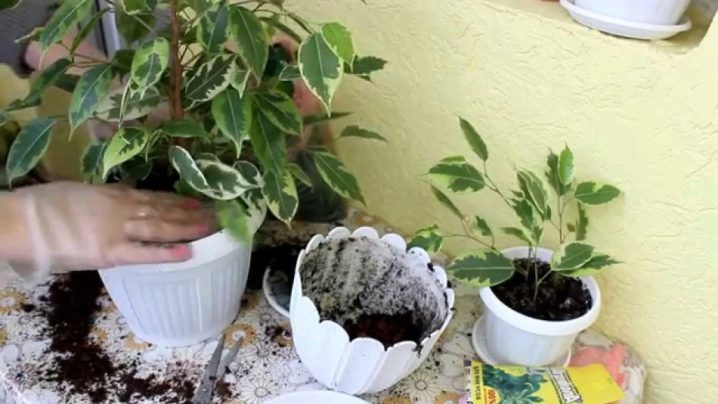
Nutrients
Poor diet is one of the common causes of chlorosis. In addition to hydrogen, carbon and oxygen, plants need more than a dozen minerals to survive, all of which must pass through their roots. If the plant runs out of iron, the new leaves will turn yellow while the old ones remain green. With a lack of nitrogen, the opposite is true. Iron is combined with calcium, sulfur, boron, copper, manganese and zinc.
When a lack of nitrogen appears in old leaves, chlorosis manifests itself relatively uniformly throughout the leaf and its veins. Potassium deficiency usually starts at the edges of the leaves and the spaces between the veins.
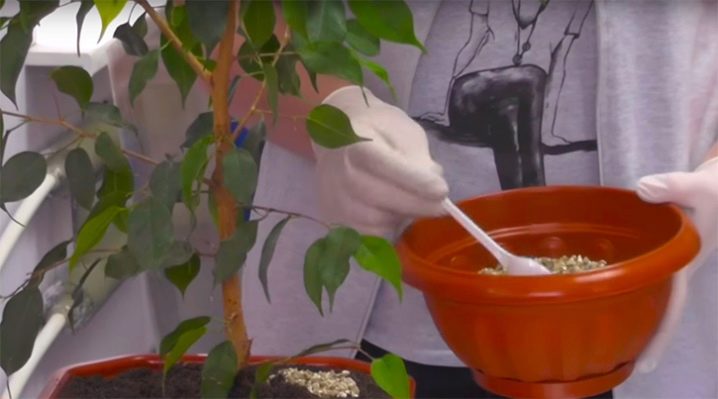
Yellowing of the leaves may indicate the need to add iron to the soil, in which case a uniform yellowing with small green veins appears.
Diseases and insects
Ficus is notorious for dropping leaves every time the environment changes, but sometimes the problem is not at all due to improper care. While insufficient and excessive amounts of water are the two most common causes of yellowing of leaves. If ruled out as potential causes, pest infestation may be to blame. Although insects are difficult to see with the naked eye, mealy or spider mites are frequent unwelcome guests. Tiny holes in the leaves, fluffy white wax on the plant, the mite is to blame. To suppress infestation, you can try washing the plant in the shower, trimming off affected, wilting leaves, or treating it with an insecticidal spray.
Mealy mites are known to negatively affect the healthy growth of ficus. Growers are advised to use natural pesticides if there are signs of infestation. If a person is able to determine the ideal place for the plant and provide the necessary growing conditions, his foliage will remain glossy green. Anthracnose turns the tips of the leaves yellow, then dark brown. Infected tissues develop pale pink pustules. Such contamination enhances the penetration of diseases. The best treatment is to immediately remove and destroy the infected leaves. Fungal diseases are treated with fungicides, you can use neem oil, which is no less effective in the fight against insects.
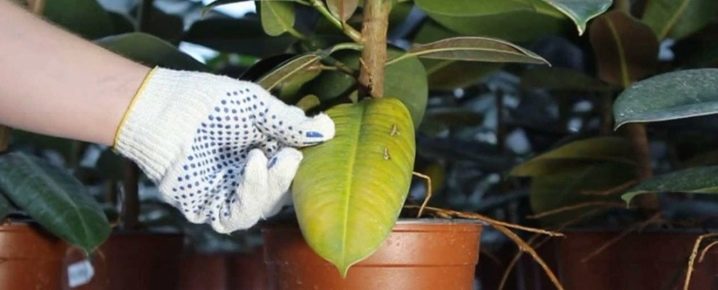
Professional advice
There are a few tips from the pros to take into account.
- The most common problem is too much or too little water. To check how much moisture your plant is getting on a daily basis, you need to use a moisture meter or simply immerse your finger 3 centimeters in the soil. If the soil is dry, the plant is most likely thirsty. In this case, watering is not enough, so it is worth doing it more often. But waterlogging can be recognized by the smell of mold, not only when dots appeared.
- If the plant is in a shaded corner, it may be necessary to consider replacing it on a sunny windowsill for a few hours. When a houseplant is next to a window with blackout curtains, it is simply enough to open them for a day, and then close them again in the evening.
- Many indoor plant varieties are tropical and, as expected, are not big fans of drafts. If you keep the ficus near the window in winter, you should not be surprised if the leaves turn yellow. The colder the environment, the less often the plant needs watering, since moisture in the soil will not evaporate as quickly as it would need.
- Some growers think their flower is getting all the nutrients it needs from the soil, but if the leaves turn yellow, this may indicate a deficiency that is interfering with photosynthesis. It should always be remembered that minerals are washed out of the soil in pots with drainage faster. If the old leaves on the plant turn yellow and the new ones are light green, this could be a sign of nitrogen deficiency. You can feed it with infusion of wood ash.
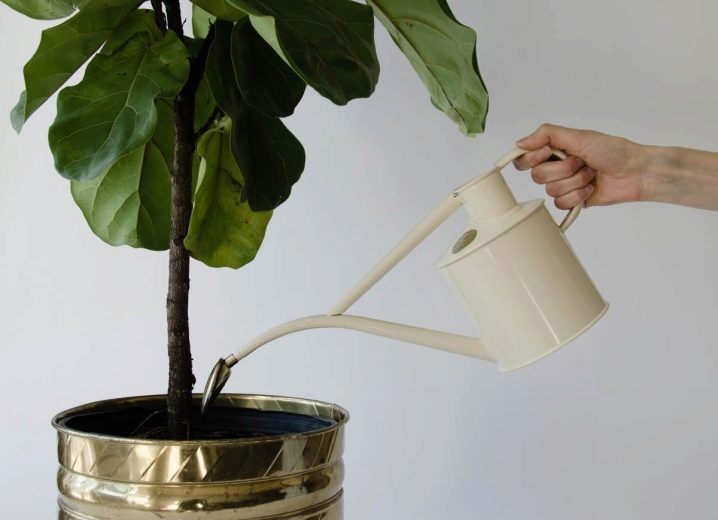
If you provide high-quality care for the ficus, then most problems can be avoided, however, the prevention of insects will only bring benefits.































The comment was sent successfully.